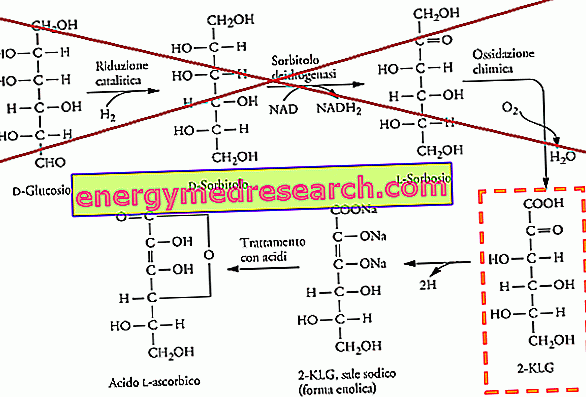L-ascorbic acid is naturally present as vitamin C; they contain citrus fruits, kiwis, blackberries, peppers, broccoli and rocket to a significant extent. In these plant sources the vitamin C content is around 100 mg per portion. An important quantity, since the daily requirement of L-ascorbic acid for an adult is around 60 mg. Despite the relative ease with which it is possible to abundantly cover these needs with simple nutrition, the antioxidant properties of vitamin C have contributed to making it one of the most widespread and sought-after supplements. According to his supporters, in fact, dietary intake is not enough to fully enjoy the precious virtues of this vitamin; the issue was analyzed in the article: vitamin C supplements.
The L-ascorbic acid contained in the drugs, in the supplements or added as an additive to various food products, is not extracted directly from natural sources, but synthesized in the laboratory (alternatively it is possible to administer herbal products rich in natural vitamin C). The first to produce "artificial" Vitamin C were the English chemists Sir Walter Norman Haworth and Sir Edmund Hirst, between 1933 and 1934, years in which even the Polish chemist Tadeus Reichstein achieved the same result.
The synthesis process starts from D-glucose and assigns the various transformation steps to chemical reactions and / or microbial fermentation processes (bacteria).

Thanks to genetic recombination techniques, Erwinia strains have been obtained that express the 2, 5-DKG-reductase gene; the enzyme encoded by this gene is able to transform 2, 5-dicheto-D-gluconic acid (2, 5-DKG) (obtained by bacterial fermentation of glucose) into 2-KLG. Consequently, as shown in the figure, these Erwini a strains are able to directly perform the conversion of glucose into 2-KLG, eliminating the original need for various chemical processes.
Once obtained, L-ascorbic acid can be salified or esterified with fatty acids. In the first case the hydrophilicity of the molecule is maintained and its acidity is reduced. In the second, instead, a lipophilic substance is obtained and as such it can be added to oils and fats to prevent rancidity.
The salts of L-ascorbic acid are generically called "ascorbates" and take the name of the mineral that characterizes them (potassium ascorbate, sodium ascorbate, calcium ascorbate, etc.).
Since there is no structural difference with the food counterpart, synthetic vitamin C carries out the same biological action as the natural one. Obviously, however, taking 100 mg of vitamin C from a calcium ascorbate tablet is not like eating a large kiwi, for example. Although the amounts of vitamin C ingested are roughly the same, kiwi - and vegetables in general - contain many other substances with synergistic action or in another way beneficial for the body.



